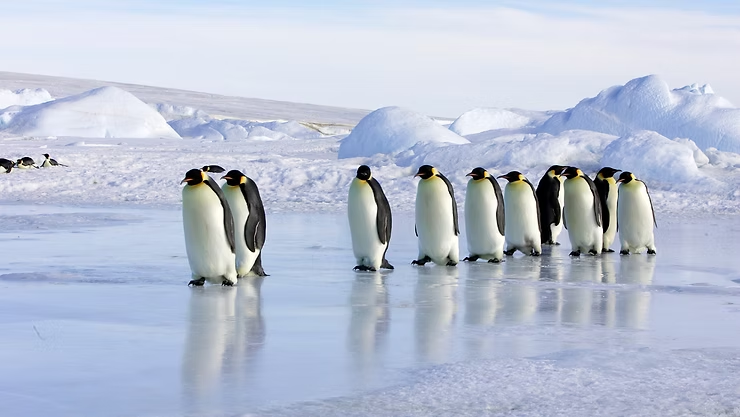Emperor Penguins: Masters of Survival in the Antarctic
Emperor penguins are iconic inhabitants of Antarctica, captivating us with their resilience, unique adaptations, and remarkable journeys.
Key Takeaways
- Dense feathers and thick fat layers provide insulation against extreme cold.
- Males incubate eggs while females hunt, forming strong family units.
- They undertake long migrations to reach breeding grounds.
- Complex courtship rituals involve displays, vocalizations, and mate selection.
- Chicks receive extensive parental care and feeding.
The Antarctic Habitat
The Antarctic is one of the harshest environments on Earth, yet it is rich in beauty and wildlife diversity.
- Extreme cold: Temperatures can drop to -80°C.
- Isolation: Antarctica is remote with no permanent human population.
- Abundant marine life: Krill, seals, and whales thrive in surrounding waters.
The Emperor Penguin Family
Emperor penguins (Spheniscidae) are the largest penguin species, uniquely adapted to survive Antarctic conditions.
- Size: Up to 1 meter tall and 22–45 kg in weight.
- Cold-resistant: Thick feathers and subcutaneous fat for insulation.
- Deep divers: Can dive up to 250 meters and stay underwater for 20 minutes.
- Strong family bonds: Parents travel long distances to feed chicks.
- Distinctive appearance: Black and white plumage aids in courtship displays.
The Majestic Emperor Penguin
- Deep Divers: Exceptional underwater foraging abilities.
- Agile Swimmers: Can swim 6–12 km offshore for food.
- Stylish Courtship: Distinct patterns enhance mating displays.
- Cozy Insulation: Thick feather and fat layers retain heat.
- Size: Largest of all penguins, standing tall and robust.
The Incredible Journey
Each year, emperor penguins trek hundreds of kilometers across ice to reach breeding grounds, braving harsh weather and navigating treacherous terrain. They rely on strong instincts and a remarkable sense of direction. Courtship involves males performing displays, trumpeting, and offering pebbles to attract mates.
The Challenging Mating Rituals
- Males gather in large groups under extreme conditions to attract females.
- Elaborate displays include bowing, vocalizations, and wing flapping.
- Successful pairing leads to finding suitable nesting sites for eggs.
The Adorable Penguin Chicks
- Chicks are covered in soft downy feathers for warmth.
- They rely on parents for food and protection until independent.
- High-pitched calls allow chicks and parents to locate each other in crowded colonies.
Unique Adaptations
- Thick feathers and 2–3 cm of subcutaneous fat provide insulation.
- Wings evolved into paddles for swimming; webbed feet aid maneuverability.
- Streamlined bodies reduce drag and enable diving to 1,500 feet.
- Male brood pouch allows incubation during harsh Antarctic winter.
- Streamlined bodies, fat layers, and dense feathers enable survival in extreme cold.
Threats to Emperor Penguins
- Climate Change: Melting ice reduces breeding time and habitat.
- Overfishing: Reduces krill and fish, affecting food availability.
- Pollution: Oil spills contaminate feathers and impact health.
- Human Disturbance: Tourism and research can disrupt colonies.
Conclusion
Emperor penguins are Antarctic icons, resilient and uniquely adapted to survive extreme conditions. Their journeys, courtship rituals, and parental care highlight the intricacies of life in one of Earth’s harshest environments. Protecting these magnificent creatures ensures the preservation of Antarctic ecosystems and the awe-inspiring legacy of the Emperor penguin.
Frequently Asked Questions
- What is the habitat of Emperor penguins? The sea ice surrounding Antarctica.
- How do they survive extreme cold? Thick blubber, dense feathers, and unique insulation adaptations.
- Average size? Up to 1.1 m tall and 40 kg in weight.
- What is their incredible journey? Annual trek up to 120 km inland to breed.
- Mating rituals? Vocalizations, displays, and pair bonding.
- Parental care? Shared egg incubation and chick feeding by both parents.
- Unique adaptations? Streamlined body, salt-removing gland, deep diving ability.
- Threats? Climate change, habitat loss, human disturbance, predation, and overfishing.

